Download ICT Strategic Plan 2013-18 (PDF 1.9MB)
Produced by the Department of Parliamentary Services
Introduction
Background
When Parliament House was opened in 1988 it had been designed to provide the environment, infrastructure and facilities necessary to house and support the work of the Australian Parliament for at least 200 years. It was also intended as a major new symbol of democracy, accessible to all. Today, with the convergence of communications and computing technologies, the opportunity arises to further these aims through the innovative application of technology. It is timely, therefore, to outline a plan to make the Australian Parliament a world leader in ‘e-parliament’, improving access, communication, engagement and transparency of the work of parliament and parliamentarians.
Australia is recognised as a significant presence on the world stage across a range of disciplines, industries and services. Underpinning much of this success is a significant investment and reliance on Information, Communications and Technology (ICT). ICT has matured to the point where a typical smart phone has 16,000 times more processing memory than Apollo 11 had when it landed on the moon in 1969. Our personal computing devices are physically and geographically independent of fixed networks and they provide intuitive means of reading articles, watching videos, collaborating on projects, phoning home and video-conferencing. That technology is available to anyone, anytime, anywhere and on a range of devices.
The use of new digital technologies to access information quickly, utilising the pervasiveness of broadband and other networks, provides exciting options and opportunities for the Australian Parliament to connect, operate more efficiently and be more open to the public.
The convergence of these technologies provides the context for the delivery of the parliamentary ICT Strategic plan. This plan has been developed to facilitate the Australian Parliament’s adoption of ICT becoming a showcase example, setting an e-parliament benchmark that is acknowledged both nationally and internationally.
Purpose and scope
The ICT Strategic Plan outlines how ICT will be used to connect parliamentarians, the public and the parliamentary departments to the information and services they need, building on an already solid base of using technology to support parliament.
This is the first parliament wide ICT Strategic Plan (including the electorate office network) and supporting governance model to oversee the development and delivery of ICT for parliament.
It also:
- will be used as the basis for future ICT planning and investment, providing a sound basis for investment decisions across the four parliamentary departments;
- outlines a high level implementation plan and next steps;
- outlines where efficiencies can be made and costs reduced through improved use of technology, resulting in further reduction of paper, power and travel costs; and
- will be treated as a living document that may change depending on new business imperatives or opportunities resulting from the rapid maturing or introduction of new technology.
This strategy is for the five year period to June 2018, and will be reviewed and updated annually.
Parliament of Australia ICT Strategic Plan in the context of broader plans
The ICT Strategic Plan is subordinate to the parliamentary strategic plan (yet to be developed) and provides the context of ICT planning across the four parliamentary departmental corporate plans.
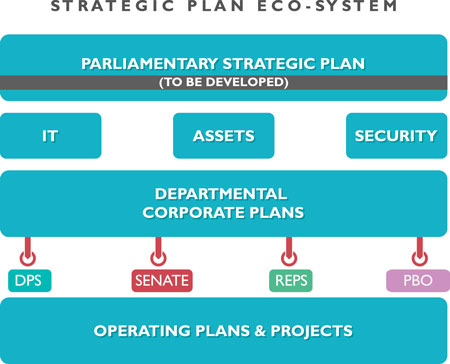
Governance arrangements
The Department of Parliamentary Services (DPS) Chief Information Officer (CIO) is responsible for the development and implementation of the ICT Strategic Plan. The Parliamentary ICT Advisory Board (PICTAB) will oversee and guide the development and implementation of the plan.
Drivers for change
The business of parliament
The business of parliament can be represented in the context of the functions, roles and processes that define and support its operation.
The objective of an open, accountable, responsive and efficient parliament can now be more readily achieved through the utilisation of existing and emerging ICT developments including increased use of video and tele-presence capabilities and secure mobile devices[1].
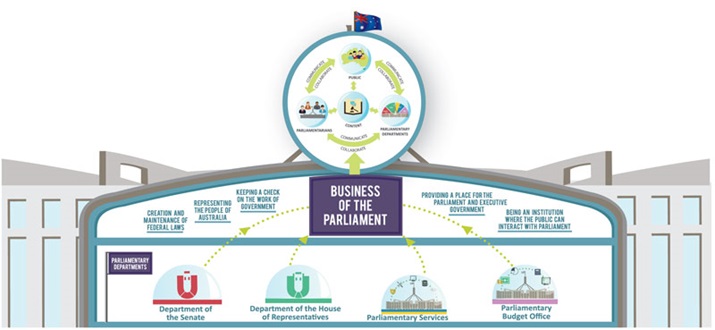
Recent reviews
Recent reviews including the Roche report Review of information and communication technology for the parliament (August 2012) and Senate Finance and Public Legislation Committee report The Performance of the Department of Parliamentary Services (November 2012) have provided valuable input to the strategy. By way of example, the key internal business drivers for ICT in the parliamentary context as outlined in the Roche review are:
- the specific business requirements of the chambers to enable parliament to function effectively;
- the requirements of the parliamentary committees;
- facilities and support to enable individual parliamentarians to carry out their duties; and
- corporate and administrative support required by parliamentarians and by the four parliamentary departments.
Parliament’s position on many of these requirements has been captured in advisory reports and these have been considered in the development of the ICT Strategic Plan[2].
In addition, a core driver of any ICT strategy in the parliamentary context is connecting the public and other stakeholders to their parliament.
Use of ICT in other parliaments
The use of ICT in the Australian states and territories as well as a selection of international parliaments (UK, European, Canadian, NZ) has been considered in the development of this plan.
The World e-Parliament Report 2012 noted that the three most important improvements in the work of parliaments made possible by ICT were:
- more information and documentation on the website;
- increased capacity to disseminate information and documents; and
- more timely delivery of information and documents to members.
While these three enhancements serve members well, they also help parliament to be more open and transparent to citizens.
ICT as an enabler
ICT can enable new ways of doing business, providing the opportunity to re-think the traditional operating models, resulting in efficiencies, convenience, cost savings and improved outcomes. While ICT is a key enabler, it is business requirements that will drive its use.
The benefits can accrue not only to parliament and parliamentarians but, through advances in digital technology, to the public in accessing and participating in parliament and the parliamentary processes.
They will also reduce the impact on the environment through a reduction of paper and the need for air travel. In the delivery of the ICT Strategic Plan, there will inevitably be a need to balance the requirement for flexibility of access with the need to keep parliamentary and parliamentarians’ data secure within budget constraints.
ICT Strategic Themes
The vision of the ICT Strategic Plan is to connect parliamentarians, the public and the Parliamentary Service to the information and services they need from anywhere, at any time, through a range of devices, and provide new opportunities for greater efficiency and effectiveness for the Parliament of Australia.
The ICT Strategic Plan is defined through four strategic themes that outline the key areas where DPS ICT will focus planning, investment and delivery:
- Supporting parliamentarians to be more effective through better use of ICT anywhere and anytime on a range of devices.
- Support for the effective and efficient operation of parliament and its committees.
- Making it easier for the public to engage with parliamentarians and the parliament.
- A capable, respected and forward looking ICT provider.
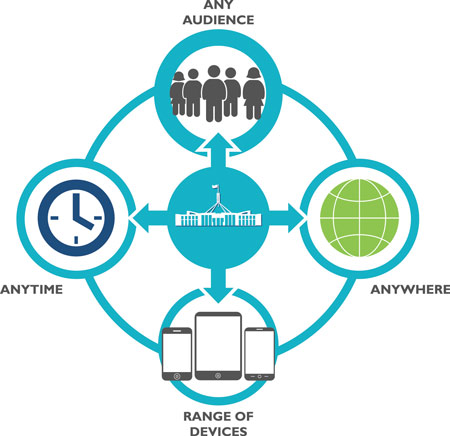
The strategic themes will be supported by an underpinning architecture that enables content to be communicated and shared interactively with other individuals, teams and communities of interest.
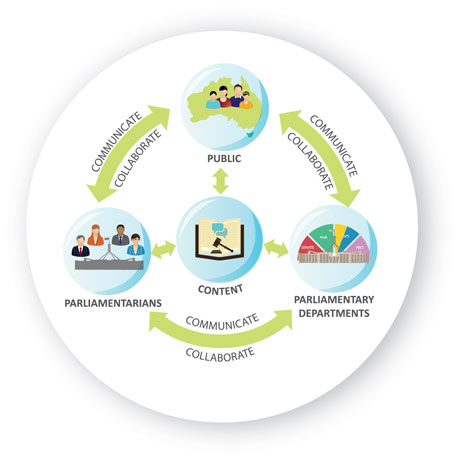
Each strategic theme includes a section outlining the key ICT capabilities required to deliver the specific business drivers. Some of these capabilities are common across multiple themes, but are only mentioned once, under the strategic theme that has the highest dependency to have it in place. Additional ICT capabilities that underpin or are common to a number of themes are included in the supplementary material supporting the ICT Strategic Plan. The complete set of ICT capabilities will form the basis of the projects that will subsequently be planned to deliver the ICT Strategy.
The objective is to establish the Australian parliament as a showcase both nationally and internationally of how ICT can improve communication, transparency and productivity.
Strategic Theme 1 – Supporting parliamentarians to be more effective through better use of ICT anywhere and anytime on a range of devices.
Key business drivers
Parliamentarians are mobile and are expected to be accessible at all times, whether at Parliament House, in the electorate offices or ‘on the road’ and therefore need flexibility in how they access information and communicate.
Parliamentary ICT systems and policies need to better reflect this requirement and provide improved levels of support to parliamentarians to carry out their duties anywhere, at any time and on a range of devices. New mobile devices from smartphones to tablets are becoming increasingly available, affordable and popular, and parliamentarians require a choice of mobile devices that are secure, seamlessly synchronised and link readily to a range of parliamentary systems.
Required ICT capability
The ICT Strategic Plan outlines an approach that provides greater choice in devices and support services, moving away from the ‘one size fits all’ model to one that better recognises that users are primarily mobile rather than fixed in a location, and allowing them to tailor their office systems to meet their individual requirements.
Future ICT solutions will be device neutral and content will be available in a range of formats complying to standards to enable flexibility of access to information from a range of devices. A key principle to support content creation and delivery is to create once (independent of application, device or location) to enable accurate, consistent and efficient storage and re-use of information.
A key element of this strategic theme is the introduction of the ‘one stop shop’, providing a flexible choice of devices and single point of ICT support for parliamentarians and their staff. Other areas where DPS ICT will further support parliamentarians and their staff are also outlined below.
The ‘one stop shop’ will provide a flexible choice of devices and single point of ICT support for parliamentarians and their staff.
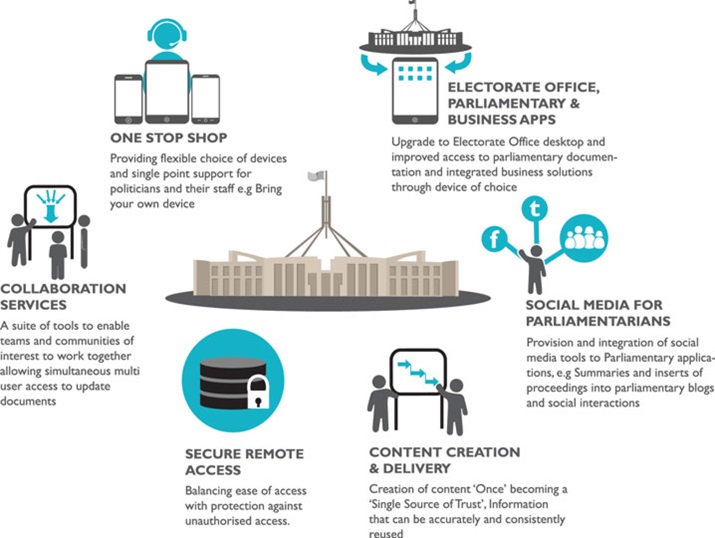
The One Stop Shop
The new one stop shop will provide a flexible choice of devices through a concept of ‘managed diversity’ for parliamentarians within their entitlements through a structured model which gives:
- a core set of equipment to support parliamentarians and their offices. While this equipment will be able to be personalised to best meet individuals’ needs, it will also be designed to enable easy ‘inheritance’ of equipment;
- the availability of a discretionary pool of funding for other devices of choice which are easily available through the One Stop Shop and supported by DPS ICT;
- the ability to Bring Your Own Device (BYOD) which will be self- managed but have access to parliamentary content as long as they are able to access the standard connectivity products;
- programmed refresh of DPS provided devices as they reach end-of-life; and
- improved support to parliamentarians as they change their role (devices re-useable and/or redeployed to successor).
Improved access to parliamentary documentation and integrated business solutions through device of choice.
Mobile and parliamentary business applications
DPS ICT will provide strategic advice, guidance and support to parliamentarians’ offices for their IT platforms and business applications, including:
- guided selection of software designed to support and manage the business (e.g. email, document management) and that safely operates within the Parliamentary Computer Network (PCN);
- an ability to secure databases and authorise access to IT systems specific to communities of interest or organisational boundaries; and
- easy and convenient access to parliamentary systems (new and existing business applications) including interfaces through mobile applications.
DPS ICT will provide strategic advice on the selection of technology and software for the electorate office that will safely operate on the PCN, and, where required, provide guidance and installation support. Specific areas for technology and software advice include:
- electronic document management;
- collaboration technology to allow real-time access and updates to documents;
- contact management tools;
- telephony integration providing automatic redirection of calls to required devices and integrated messaging,
- converting voice to text and conversely, text to audio; and
- video conferencing, allowing senators and members video communication with their staff, constituents, committees or local groups.
Parliamentarians and staff also require the ability to secure and protect information, based on approved and authorised access. An information architecture is being developed that will identify key data groups and interactions where access rules can be applied based on roles and other policy considerations to safeguard data. Where further protection is required, DPS ICT will look to segment the PCN to provide network-level security.
.......upgraded search facilities together with new purpose built mobile applications will provide timely access to information...
Over the strategic planning period, there will progressively be a greater opportunity to access information in digital format (e.g. e-Hansard, e-committees, etc), together with extensions to existing systems (e.g. AVAMA, TOPS, etc). Subject to relevant policy and security considerations, the website and the parliamentarian’s device of choice will enable access to these services and will provide integrated media solutions (video/audio/text) through mobile and other devices. Upgraded search facilities together with new purpose built mobile applications will provide timely access to parliamentary information.
Collaboration services
Collaboration technology enables teams and communities of interest to work together, including the ability to allow simultaneous access to update documents. DPS ICT will progressively develop collaborative services with initially simple conversational capabilities to enable parliamentarians to invite feedback and conversations on topics with the electorate, and to more advanced use of collaborative technologies over time. The use of collaborative technology will evolve through:
- live interaction;
- flexibility of capturing input from a variety of sources; and
- integration of different mediums to collaborate.
Social media services
A number of parliamentarians have commented that their constituents were now conducting business and social interaction electronically and, as a consequence, expected to be able to interact with their parliamentarians in much the same way.
Apart from the provision of tools to enable interaction through social media, DPS ICT will keep abreast of advances in social media technology and where appropriate, look to integrate it with other business processes.
Secure remote access services
Of paramount importance in the underpinning architecture to support Anywhere, Anytime, Any Audience and access through a range of devices will be the security and privacy of data. Parliament ICT systems have adopted the controls as outlined in the Australian Government Information Security Manual as the basis of the IT Security Management System to mitigate security risks. The security architecture to support the ICT Strategic Plan will be developed balancing ease of access with protection against unauthorised access, using a layered model of security based on risk.
Security.....balancing ease of access with protection
Strategic Theme 2 – Support for the effective and efficient operation of parliament and its committees
Key business drivers
Trends in parliaments across the world are demonstrating that innovative business processes supported by the appropriate ICT tools and platforms can result in the more effective and efficient operation of parliamentary systems.
Common examples include the increased digitisation of documents, with some international chambers and committees now being paperless, electronic voting and remote access through video conferencing. Such changes are enabling parliamentarians to actively participate in the parliament regardless of their location and to access vital information more quickly. There are also demonstrable reductions in printing, document distribution and travel, and these have both a financial and an environmental benefit.
ICT opportunities
Strategic use of technology will result in the digitisation of documents providing a whole range of opportunities and benefits......
Strategic use of technology will result in the digitisation of documents providing a whole range of opportunities and benefits described below. These include: ICT support for parliamentary functions (including functions to support chambers and committees) to enable a more efficient and open parliament; integration of technologies to provide a richer user experience; rationalisation of systems to reduce licence and support costs; an Information Management Strategy that underpins the capability to source information readily from disparate sources; and the extension of parliamentary ICT based services (e.g. broadcasting, telephony and ICT back up servers).
The explosion of mobile devices and webcam technology demands that information be captured in digital format to enable timely interaction and presentation in multiple forms. Digital technology in the parliamentary context includes:
- e-documents (including e-Hansard) – this allows documents to be more easily searchable and provides the ability to quickly extract components of information to meet specific needs;
- e-documents can also be easily distributed and integrated with other media (collaboration tools, document management systems, video) to provide more efficient processes, particularly in geographically dispersed areas, and richer interaction;
- e-voting – the means to more quickly record and determine the results of voting in the chambers;
- e-petitioning – the capability to enable the public to electronically lodge petitions in line with the House of Representatives Standing Committee on Petitions report Electronic petitioning to the House of Representatives (October 2009) and the Senate Procedure Committee’s First Report of 2013 Electronic Petitions (February 2013);
- e-committees – ICT can provide additional support to many committee functions including extending the electronic distribution of papers, remote access to hearings, etc;
- systems to compile and distribute procedural information and documents to support the business of the Houses and their committees;
- systems to compile, distribute and archive formal and informal records of the Houses and their committees;
- geographically remote attendance through video and web technologies;
- richer and more varied forms of collaboration including contributions independent of time and geography (e.g. blogs, wiki, Twitter);
- auto captioning – speech recognition (voice to text) is used for auto captioning and transcript production resulting in near instantaneous transcript delivery (in line with Web Content Accessibility Guidelines Version 2.0);
- seamless accessibility – seamless accessibility to information services through virtual desktop interfaces (VDI), security control, peripheral devices (e.g. computer, printer);
- improved search capability on structured and unstructured data – through the introduction of superior search technology utilising automatic indexing capabilities, provide a step change improvement in the ability to search on structured and unstructured data; and
- provision of information based on personal profiles – at a time when many people experience information overload, introduce push and pull technology to select and classify information based on personal profiles.
For ICT to implement these technologies, further foundation capabilities will need to be developed including:
- definition of the underpinning architectures;
- an Information Management and Digitisation Strategy; and
- a security model.
Strategic Theme 3 – Making it easier for the public to engage with parliamentarians and the parliament
Key business drivers
Changing community expectations about access to information and a more active engagement in the parliamentary process present new opportunities through the use of ICT for the public to be more easily and directly involved with parliament and parliamentarians.
Developments in ICT are increasingly enabling parliamentarians to communicate with individuals and groups through email, video conferencing, websites and social media.
As technology becomes more consumer-friendly and affordable and as broadband speeds increase, many more forms of interaction are becoming possible.
Under the ICT Strategic Plan a significant focus will be on increasing the connection between citizens and individual parliamentarians as well as the broader community with the parliamentary process as a whole.
Increased use of video and teleconferencing will enable parliamentarians to easily communicate with each other and their constituents
Technology to assist participation in the democratic process
DPS ICT has already invested significantly in digital technology to capture and broadcast the workings of parliament. For example, the AVAMA project has provided the ability to digitally record sessions of parliament and committee proceedings enabling high quality delivery of sessions through various networks and the archival, and efficient retrieval, of proceedings.
Further developments to enable a closer link between the operations of parliament and the community include:
- provision of captioning services to increase the accessibility of parliament and committee proceedings;
- expanded use of e-documents so that parliamentarians and the community have faster, easier access to Hansard, committee papers, chamber documents, reports, etc.;
- increased use of video and teleconferencing through consumer-based tools such as Skype to enable
- parliamentarians to easily communicate with each other and with their constituents using their own devices;
- enhanced broadcast quality and secure tele-presence facilities that will, for example, allow parliamentarians to participate remotely from their electorate in committee hearings in Canberra or elsewhere, and will enable constituents and groups, including people in remote areas, to contribute to policy discussion in a meaningful way.
- increased use of social media to increase the interaction between parliamentarians and stakeholders; and
- providing systems where petitions can be raised and managed for the parliament.
Skype-like services will be available as a base capability, utilising the pervasiveness of the internet to allow an ‘any to any’ style connection. More sophisticated open-standards based technology that will enable a higher quality user experience, integration with other technologies (collaboration, voice to text etc) and more secure communication will be available to any destination that has, at a minimum, a webcam.
In developing this capability, upgrading technology in committee rooms will be required to support collaboration and audio visual commentary on appropriately positioned and configured presentation screens, being mindful of compliance with the design integrity of the building. The tele-presence capability will also be extended to facilities other than the secure, locked down facility currently available.
Providing better access to information
In addition to enhancing opportunities for active participation and engagement by citizens, the ICT Strategic Plan will also help deliver more accessible and streamlined information about parliament.
The Parliament of Australia website should be the first port of call for all Australians interested in learning about the work of the parliament, its committees and members. Australians will be able to search and access the full range of output produced by the parliament, across a broad array of media, meeting all relevant Web Content Accessibility guidelines.
Students will have ready access to media-rich resources, while the Parliamentary Education Office (PEO) will be able to interact with multiple schools simultaneously, reaching more schoolchildren than ever before.
Archived video of parliamentary proceedings will be available and fully searchable, right down to individual speeches, which in turn, will be linked with the relevant Hansard, and associated material.
Technology to assist visitors at Parliament House and online
The Australian Parliament House was designed to be “the people’s house”, a symbol of democracy accessible to all. Investment in new technologies will make that goal more achievable than ever before.
There are many opportunities where technology can improve the visitor experience....... and make parliament electronically accessible to people who are unable to visit in person
There are many opportunities where technology can improve the parliamentary visitor’s experience. These include web based virtual tours, greater use of tactile technology, mobile applications to provide information on items of interest and assist in describing tours around parliament, robot technology and make parliament electronically accessible to people who are unable to visit in person. Finally, technology enables collaboration, video-conferencing and social media tools that allow for direct interaction with parliament.
For the visitor to Parliament House, technology will be further exploited in audio/visual presentations, interactive displays, three-dimensional presentations and geographic engagement services where the aim is use the technology to engage with individuals during their visit to the parliament.
Since late 2012 free public wi-fi has been available in most areas of the building. This will allow the creation of improved self-guided tours and in-depth information for visitors interested in, not only the operation of parliament, but also the architecture, landscaping, art collection and other important aspects of Parliament House.
For the online visitor, the same principles apply so that the experience is no less than that of visiting the building itself. This can be offered through the use of site feeds, websites and use of social media channels and tools that allow the content to be re-distributed.
Strategic Theme 4 – A capable, respected and forward looking ICT provider
Both the Roche report and the Finance and Public Administration Committee inquiry highlighted the need for a reduction in the fragmentation of responsibility in the delivery of ICT services to the parliament. They concluded that a more consolidated ICT division would have the expertise, customer focus and scale to deliver more effective and efficient services to parliament and parliamentarians.
Other ICT operational matters raised in the Finance and Public Administration Committee Inquiry and addressed under this Strategic Theme relate to enhanced processes, discipline and governance to improve:
- consistency in the delivery of ICT services;
- clarity in service provision;
- responsiveness to emerging technologies;
- positioning against security threats; and
- reliability of services.
Cost pressures on ICT continue to mount and one way to address these is to simplify and rationalise the way services are delivered. In addition, the current environment is overly complex, having multiple legacy (unsupported) and siloed systems. This means that a broad set of skills and a range of vendors are needed to support the environment, all at considerable cost.
Finally, as there is no clear understanding of the interconnectedness of many of the systems, the environment is fragile, with a consequential risk to changes that are applied. Rationalisation of ICT systems over the planning period will take into consideration a range of approaches resulting in a reduction of risk and cost as well as improved support and time-to-market for ICT changes.
As well as addressing the specific business drivers outlined above, ICT will be used to improve the speed and flexibility of access to information; to reduce the environmental impact through reduction in paper use; to increase accuracy through a range of disciplines, architectures and technologies; and to reduce operating costs for current services.
Customer focused ICT services through service level agreements and improved rigour in project delivery
Principles in ICT delivery
Principles to support the delivery of the ICT capabilities include:
- supporting production applications through service level agreements, ensuring critical applications have appropriately skilled resources available to address system issues.
- facilitating standard cross-chamber system solutions for similar functionality, striving for common solutions wherever appropriate, but enabling some local customisation of business rules for each chamber where required;
- providing appropriately skilled resources for all aspects of the systems development lifecycle;
- delivering ICT solutions in the context of the underpinning enterprise architecture, ensuring an integrated and structured approach to the delivery of solutions;
- developing risk based IT security policies, controls and processes based on the Australian Government Information Security Manual (ISM);
- exploring COTS/Cloud technologies before development of in-house bespoke solutions;
- where appropriate, taking advantage of whole of government capabilities and services (such as shared procurement arrangements, data interchanges, security services) to maximise efficiency and interoperability with other agencies; and
- having technology solutions that are device independent.
Integration of key systems
Integrated systems will be a crucial means of delivering improved service and value for money during the period of this plan. These will include:
- implementation of an Information Management Strategy which will enable system data to be stored in the appropriate format (together with its associated metadata) so that data can be efficiently extracted and combined to dynamically form new sources of information to meet individual or specific information requests;
- integration of key elements of the parliamentary business systems (i.e. TOPS, SCID, CommDoc, Bills System) in line with the underpinning service delivery architecture;
- expanding parliamentary video and audio content to deliver in multiple media formats (including content delivery networks);
- upgrading the telephony system to utilise Internet Protocol (IP), which will integrate the desktop with the telephony system, resulting in greater flexibility in communication; and
- implementing back up for the servers in the central computer room – virtually all of the PCN servers are located in a single computer centre with no off-site backup.
Underpinning these changes will be a strengthened governance, planning, service delivery and funding regime.
Governance
In a complex business environment such as the parliament, effective governance controls are vital. The governance framework will include appropriate levels of consultation, and advice, decision-making controls, all of which will ensure services remain relevant, secure and effective. These will include:
- well governed, transparent, consultative, Control Objectives for Information and related Technology (COBIT)
– the focus of COBIT is illustrated by a process model that subdivides IT into four domains (plan and organise; acquire and implement; deliver and support; and monitor and evaluate); and
- improved rigour on project disciplines, focusing on project outcomes, and increasing confidence in delivery.
Skills, culture, operations and service delivery
In addition to the benefits of removing fragmentation from service delivery, the Roche report identified other benefits in having a single ICT entity. The implementation of the ICT Strategic Plan will be led by a CIO and a skilled team that understands and responds to the particular working environment of parliamentarians and the role of parliament in the community. In this context the DPS ICT Division will:
- be respected and recognised as ethical and transparent in its decision making;
- act collaboratively with others in delivering services;
- develop an IT services catalogue, standards and service level agreements covering the provision of services;
- increase the level of DPS ICT support during sitting periods and the days leading up to and following sitting periods;
- be adaptive and responsive in the delivery of services;
- have the right skills and structure to both deliver services and drive innovation;
- be recognised as being focused on service delivery;
- focus on quality outcomes;
- offer a single point for ICT support that responds to user needs;
- operate in a culture of continuous learning; and
- appropriately manage contracts for off-site services that support remote access; develop solutions and quickly rectify problems.
....responsive, transparent, quality outcomes, continuous learning......
Funding
As ICT is a critical enabler for the operation of parliament and vital to the work of parliamentarians, appropriate costing and funding models must exist to underpin this strategy. For example:
- funding for ICT will cover the provision of agreed baseline services;
- where appropriate service level agreements will be in place to specify roles and responsibilities, standards and resourcing arrangements;
- a catalogue of ICT services and equipment will be available together with associated charges and costs; and
- funds for major initiatives in the ICT Strategic Plan will be subject to business cases and funding proposals.
Roadmap and next steps
Six programs of work have been defined to address the business drivers and deliver the outcomes to enable the vision of the ICT Strategic Plan.
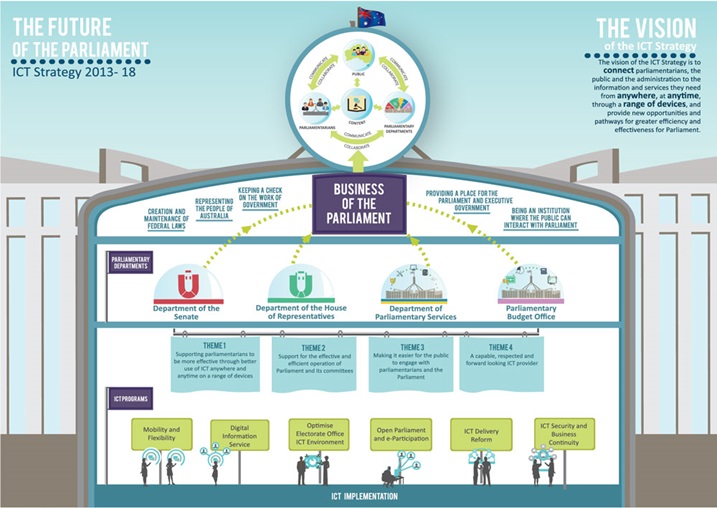
ICT Strategic Initiatives
The mapping of business drivers to outcomes through the delivery of the six programs (including the initial set of initiatives/projects) is outlined in the high level roadmap below.

Next steps
The full take-up of these opportunities will rely on parliamentary policy decisions and availability of funding. Over the five-year planning horizon, DPS ICT will be working with the parliament, the parliamentary departments and advisory committees to determine the extent these technologies will be utilised, giving consideration to cultural, policy, political, legislative and financial matters.
The 2013–14 year will be characterised by the:
- delivery of immediate improvements (one stop shop, electorate office support and guidance, elements of e-Hansard, website upgrades);
- significant strategic functionality delivered through the SCID and TOPS systems;
- implementation planning for medium-term initiatives – development of business cases and funding proposals to deliver major programs/projects;
- development of the enterprise architecture; and
- establishment of governance, ICT resource and risk management plans, project dependencies and 2014–15 project initiation documentation.
Consultation process
The ICT Strategic Plan was developed over the period January to June 2013, with input from a broad range of stakeholders as outlined in the supporting Stakeholder Engagement Plan. Consultation included contributions through formal user groups largely reflecting the DPS ICT customer base, as well as ‘one on one’ meetings to capture specific input.
Advisory reports
Various reports were included for consideration in the development of the ICT Strategic Plan including:
- Hansard as a record in the 21st Century project report (2011);
- Agreement for a Better Parliament: parliamentary reform, House of Representatives (October 2010);
- Electronic petitioning to the House of Representatives (2009);
- Making a difference: Petitioning the House of Representatives (2007);
- House of Representatives Standing Committee on Procedure, 2006 report, Learning from other parliaments: Study Program 2006 (August 2006); and
- Memorandum of understanding between the Parliamentary Budget Officer and the heads of Commonwealth bodies in relation to the provision of information and documents (September 2012).
Glossary
|
Glossary
|
|
Spacer
|
| APH |
Australian Parliament House |
| AVAMA |
Audio Visual Asset Management and Archiving Retrieval |
| BILLS System |
Used by Table Office – management of the passage of Bills |
| BYOD |
Bring Your Own Device |
| CommDocs |
Collaborative system to enable electronic distribution of committee documents |
| PBO |
Parliamentary Budget Office |
| PCN |
Parliamentary Computer Network |
| PICTAB |
Parliamentary ICT Advisory Board |
| SCID |
Shared Committee Information Database |
| TOPS |
Table Office Production System |
| WI-FI |
Wireless computer network |
Footnotes
[1] By way of example, scenarios of how parliamentary departments, a parliamentarian, their staff and the public may interact in 2018 as a result of the capability delivered through the ICT Strategic Plan (e.g. a day in the life of a parliamentarian, a visitor to parliament and a staff member) is included in documentation that complements the ICT Strategic Plan.
[2] A list of advisory reports referenced in the development of the ICT Strategic Plan is included in the last section of this document.